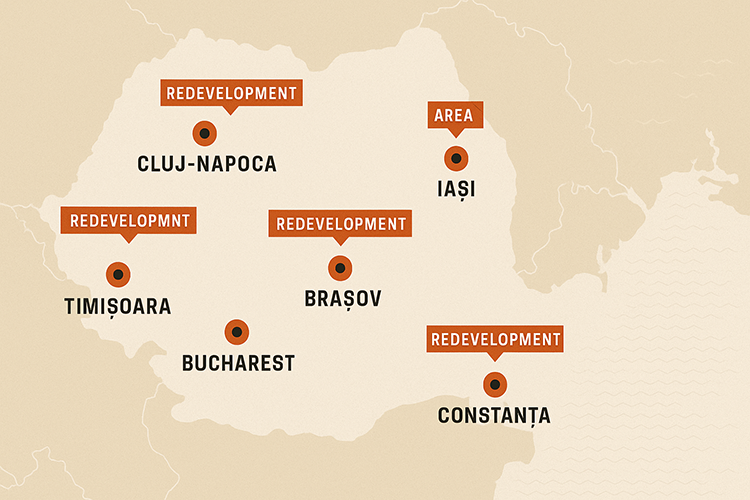Romania’s Biggest New Schemes Are Rising on Old Factory Land, but the Pipeline Is Uneven
A fresh review from Cushman & Wakefield Echinox confirms what has become a defining theme of Romania’s real estate cycle: the largest ongoing developments are increasingly anchored to former industrial platforms—first and foremost in Bucharest, but with notable momentum in regional hubs as well. The consultancy places the capital at the center of this wave thanks to the sheer depth of its market and the number of legacy sites suitable for conversion, with most major in-city land deals still clustering around ex-industrial plots and typically targeting mixed-use outcomes.
Specific platforms frequently cited by market trackers over the past few years include Rocar, Roca Preciziei, Helitube in Colentina, Muntenia near Parcul Carol, Antrefrig, Titan Mar on Șoseaua Progresului and Atlas in Pipera. These sites have been assembled for large-scale pipelines rather than piecemeal infill, underscoring the appeal of multi-hectare footprints with urban infrastructure already in place.
The investor roster behind this regeneration push spans domestic and international capital. Prime Kapital features prominently in regional cities—most visibly in Iași, where Mall Moldova opened in April 2025 as the largest shopping center outside Bucharest and forms part of a broader plan that includes the Silk District on a historic factory site. The scheme is presented by the developer as an urban regeneration anchored to former industrial land; independent trade press has echoed both the opening and the “largest outside Bucharest” framing.
Cluj-Napoca offers a snapshot of the next wave. The Rivus project is reworking roughly 14–17 hectares of the former Carbochim platform into a mixed-use district with retail, culture, offices and parkland, backed by a financing package billed as the largest loan to a Romanian real-estate development this year. A separate seven-hectare acquisition of the Tehnofrig site by Hexagon adds another conversion to the city’s pipeline. Together, these moves validate the view that ex-industrial land is driving today’s flagship schemes.
Elsewhere, the Tractorul platform in Brașov remains the emblem of scale—roughly 100 hectares progressively transformed over the past decade—while Constanța has become the new headline. Iulius has launched what it bills as Europe’s largest private bioremediation to clean up 38 hectares of the former Oil Terminal site ahead of an €800m-plus urban project designed by Foster + Partners. Reports confirm the scope, the remediation spend and the site history.
Underlying occupier demand helps explain the push. Industrial and logistics leasing surged by more than 30% year-on-year in early 2025 to nearly 260,000 sqm, with net take-up accounting for 70%—a sign of genuine growth rather than churn. The national stock is on track to reach eight million sqm if current development pace holds. Those dynamics help explain why well-located former platforms are being re-priced as mixed-use districts rather than replaced like-for-like with warehouses.
Not every claim travels equally far. Reports frequently state that many Timișoara platforms have already been repurposed and that Spumotim and 1 Iunie could yield new landmarks next. These are flagged as active or expected sites, but “most” being fully transformed is difficult to verify. Likewise, the observation that Craiova and Arad are drawing increased attention is presented more as an outlook statement from brokerage commentary than as evidence of closed transactions.
Two caveats belong alongside the opportunity set. First, conversion costs can be significant: remediation, utility upgrades and permitting add time and capital expenditure, as Constanța’s Oil Terminal clean-up illustrates. Second, while central or peri-urban locations and large land banks are advantages, local planning rules and community engagement can shape both product mix and phasing.
Bottom line: evidence from brokers, developer disclosures and independent reporting all point in the same direction—Romania’s most ambitious new quarters are rising where factories once stood. Bucharest still leads on volume, but Iași, Cluj-Napoca, Brașov and Constanța now anchor a broader map of regeneration. The opportunity is real; the execution depends on planning, remediation and capital discipline.








